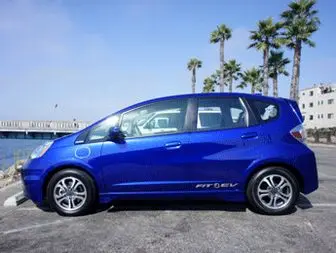
Driving a blue Honda Fit EV down El Segundo Blvd. in Los Angeles, I began to feel a bit guilty. To my left stretched a massive complex, a big stretch of beachfront property devoted to a Chevron oil refinery. As the Fit EV whispered by this facility, which Wikipedia told me later was founded in 1911 and gave the town of El Segundo its name, I thought of all the oil workers the little electric car I was driving would put out of a job.
Lacking a gas tank and exhaust pipes, this Fit EV would never need to sully itself at one of the many gas stations I passed on this drive through Los Angeles, except maybe to top off the air in the tires. The Fit EV represents one of the new breed of electric cars, which current battery technology is making more practical for daily use. And in my drive I found the Fit EV the best of the bunch.
Honda recently got to crow about the Fit EV ' s EPA numbers, boasting the car ' s average fuel economy of ۱۱۸ miles per gallon equivalent for the combined city and highway number. That makes the Fit EV the most efficient car yet tested by the EPA. However, the mpge number cited for electric cars probably won ' t mean much to most drivers, and only a power company engineer could truly appreciate the ۲۹ kilowatt - hour - per - ۱۰۰ - miles number that Honda includes in its spec sheet for the Fit EV.
Range will be at the top of most drivers ' minds, and here the Fit EV only scores ۸۲ miles in the EPA tests. Not a bad number for new electric cars, but nothing revelatory. More in the car ' s favor is the ۳ - hour charging time when using a ۲۴۰ - volt source, thanks to its ۶.۶ - kilowatt onboard charger. Of course, charging the Fit EV will be cost a lot less than filling an equivalent car with gasoline. Honda broke down the numbers for me, citing a savings of about $۴,۰۰۰ in three years for charging the Fit EV over paying for gasoline.
The other electric cars on the market, the Nissan Leaf, Ford Focus Electric, and Mitsubishi i - Miev, compare well enough with the Fit EV on various of these specifications, but I found something about the Fit EV that I haven ' t found with these other cars; it was actually kind of fun to drive. Leaving Tesla aside for the moment, the Fit EV had, along with the de rigueur Eco button, a Sport button. Honda actually included a mode that would tap most of the power train ' s acceleration potential, whilst also putting a big drain on the battery. Other EV makers focus exclusively on getting the most range out of their cars.
When I began my drive in the Fit EV, a little range anxiety had me driving in Eco mode, wanting to preserve the ۸۶ miles displaying on the instrument cluster. This mode reins in the full potential of the battery pack, and also hobbles the air conditioning so as to maximize range.
When the range did not plummet precipitously and the Los Angeles heat began to make me sweat, I relented and pushed the Normal button. As the green accent lighting faded from the instrument cluster, so did the lassitude of the accelerator. The Fit EV assumed a zippier character, ready to pounce off the line as traffic lights turned green. The potential range also dropped about ۵ miles, but as the air conditioning stepped up to a more comfortable level, I felt it was a worthwhile sacrifice.
With the more responsive pedal, I was able to appreciate the handling of the Fit EV. It felt lighter and nimbler than both the Focus Electric and Nissan Leaf, and not much heavier than a gasoline - engine Fit. Honda constructed the Fit EV cleverly, raising the chassis about ۱.۵ inches to accommodate a ۲۰ kilowatt - hour lithium ion battery pack underneath the car ' s passenger compartment. That positioning makes the extra weight less noticeable. It also raises the passenger seating position to that of a minivan or small SUV, giving the Fit EV driver a more commanding view of the road than in a standard Fit.
Honda also said that, due to some of its efficiency technologies, the Fit EV gets by with a smaller battery pack than some of its competitors, while still getting equivalent range. Certainly the mpge figure it earned shows that efficiency.
One such technology is the way its regenerative braking handles a downward slope. I found a few good descents to test the car ' s grade logic. Instead of building speed as I sent it downhill, the car automatically maintained its initial speed without me having to touch the brake pedal. The car applies regenerative braking when going downhill to maintain a steady speed, and also to charge up its batteries. If I wanted more speed, I merely had to touch the accelerator a bit. It was kind of like cruise control.
The real fun came after I saw the car still had ۶۰ miles of range, and it was getting close to the time to return it to Honda. Engage Sport mode, and the instrument cluster turned an angry red. Suddenly, the full ۹۲ kilowatts of the electric motor was available. I had ۱۸۹ pound - feet of torque on tap, which made the little Fit EV step off the line in a much livelier manner. Normal drive mode limits the motor to ۷۵ kilowatts output, while Eco keeps it down to ۴۷ kilowatts, although pressing the accelerator hard unleashes its ۷۵ - kilowatt potential.
The easy handling and light feeling of the car contributed to the enjoyment. And although I was stripping miles off the range faster than a Las Vegas tourist losing chips at a roulette table, it made driving the Fit EV more than just an exercise in efficiency. Although far from a sports car, the Fit EV felt as responsive and fun as the standard Fit. To accommodate the battery pack, Honda even upgraded the Fit EV ' s rear suspension, going from a torsion bar to a multilink configuration.
The plant - derivative material covering seats and interior surfaces had a nice, soft feeling. The rear seats are raised even higher than the front seats, creating a stadium seating effect, and there ' s more rear legroom than in the standard Fit. However, Honda had to use conventional rear seats, rather than the Magic Seat found in the standard Fit. That means the rear cargo area doesn ' t get a completely flat floor with the rear seats folded down.
Navigation comes standard in the Fit EV, but the head unit is the same one Honda puts in the standard Fit, with a few modifications. In reviews of other Honda vehicles, such as the CR - V, I have mentioned the chunky look of the maps in the navigation system, and the Fit EV shows no improvement here. For the Fit EV, Honda superimposes the range for a one - way or two - way trip over the map, shown as a circle. Although this display does not represent actual road miles, it serves as a useful guideline.
Honda included an EV charging station category in its points - of - interest database, which differentiates between ۱۲۰ - volt and ۲۴۰ - volt stations. From a ۲۴۰ - volt station, the Fit EV can get a full charge from zero in ۳ hours. Honda points out that if a Fit EV driver were to plug in while going shopping for an hour, the car could be charged up by a third.
Along with the navigation system ' s EV features, Honda offers an app for iPhone and Android that lets drivers schedule charging and turn on the climate control remotely. The app shows the car ' s state of charge and has its own charging station finder. A key fob for the car also lets the driver initiate charging or start up the air conditioning from about ۱۰۰ feet away.
Although Honda gives a price of $36,625 for the 2013 Fit EV, the company will not be selling the car. It will only be offered on a lease basis in California and Oregon, initially. The lease cost will be $389 per month, and includes collision insurance. That rate takes into account the Federal tax credit for electric vehicles, but lessees will be able to claim California's tax incentives and an HOV lane sticker.













